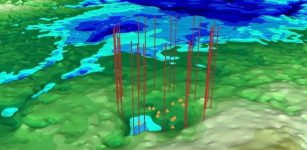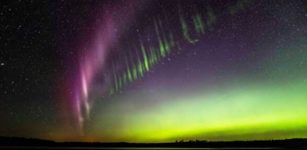How Cosmic Rays From Supernovae Affect Earth’s Clouds And Climate And Why Is It Changing? – New Research
MessageToEagle.com – The Sun’s magnetic activity continuously varies and alter the influx of cosmic rays to the Earth.
Spaceweather.com reports daily about the Sun’s activity. Today’s report is:
“A GASH IN THE SUN’S ATMOSPHERE: Magnetic maps of the sun’s atmosphere reveal a long gash, more than 700,000 km long, where solar wind may be spraying into the solar system.

Astronomers call this a “coronal hole”–a region when the sun’s magnetic field opens up and allows solar wind to escape. Coronal holes are common, appearing every few weeks. This one, however, is uncommonly long and narrow. A fan-shaped spray of gaseous material flowing from the gash could reach our planet as early as Dec. 23rd…”
A crucial breakthrough in the understanding of these events has been made by researchers led by Henrik Svensmark from DTU Space at the Technical University of Denmark.
“Finally we have the last piece of the puzzle explaining how particles from space affect climate on Earth. It gives an understanding of how changes caused by Solar activity or by super nova activity can change climate.” says Henrik Svensmark
The study reveals how atmospheric ions, produced by the energetic cosmic rays raining down through the atmosphere, helps the growth and formation of cloud condensation nuclei — the seeds necessary for forming clouds in the atmosphere. More cloud condensation nuclei mean more clouds and a colder climate, and vice versa. Clouds are essential for the amount of Solar energy reaching the surface of Earth.
It is significant for our understanding of why climate has varied in the past and also for future climate changes.

Cloud condensation nuclei can be formed by the growth of small molecular clusters called aerosols.
The new results reveal that interactions between ions and aerosols and additionally solar activity play an important a role in variations in Earth’s climate. For example, the Medieval Warm Period around year 1000 AD and the cold period in the Little Ice Age 1300-1900 AD both fits with changes in Solar activity.
Data was taken over a period of 2 years with total 3100 hours of data sampling. The results of the experiments are:
- Cosmic rays, high-energy particles raining down from exploded stars, knock electrons out of air molecules, which produces ions – that is, positive and negative molecules in the atmosphere.
- The ions help aerosols — clusters of mainly sulphuric acid and water molecules — to form and become stable against evaporation. This process is called nucleation. These small aerosols need to grow nearly a million times in mass in order to have an effect on clouds.
- Ions have also another important role. They accelerate the growth of the small aerosols into cloud condensation nuclei — seeds on which liquid water droplets form to make clouds. The more ions the more aerosols become cloud condensation nuclei.
- Important are also low clouds made with liquid water droplets because they cool the Earth’s surface.
- When the Sun’s magnetic activity varies it alter the influx of cosmic rays to the Earth.
- When the Sun is lazy, magnetically speaking, there are more cosmic rays and more low clouds, and the world is cooler.
- When the Sun is active fewer cosmic rays reach the Earth and, with fewer low clouds, the world warms up.
All these processes widely affect our climate and we see effects of these processes more and more.
Co-authors are senior researcher Martin Bødker Enghoff (DTU Space), Professor Nir Shaviv (Hebrew University of Jerusalem), and Jacob Svensmark, (University of Copenhagen).
Research paper
https://www.nature.com/articles/s41467-017-02082-2
MessageToEagle.com
Expand for references










